NUMERICAL SUMMARY OF RESULTS (ongoing, based on total of 50 seeds free-planted):
| |
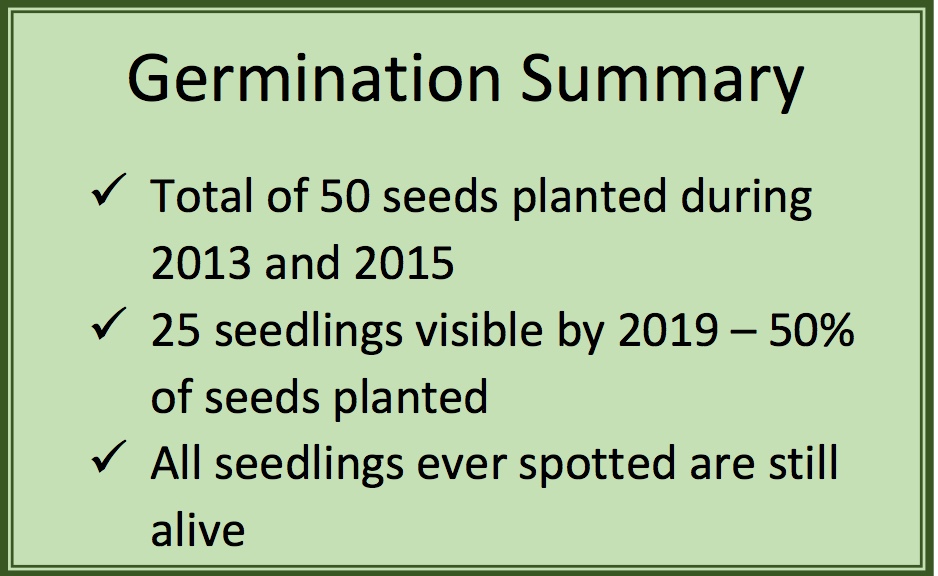 |
|
NOV 2015: 06 seedlings
MAY 2016: 06 seedlings
NOV 2016: 10 seedlings
MAY 2017: 11 seedlings
NOV 2017: 22 seedlings (15 from 2013 seeds; 07 from 2015 seeds)
DEC 2018: 25 seedlings (15 from 2013 seeds; 10 from 2015 seeds)
NOV 2019: 23 seedlings (15 from 2013 seeds; 08 from 2015 seeds)
|
Note: The most recent report NOV 2019 showed magnificent seedlings in Part 1 (the original freeplanted seeds of 2013), with only two or so evidently browsed. However, the freeplanted seeds of 2015 in Part 2 showed 3 sudden brownings (presumed dead), with just 8 seedlings remaining — many of which evidence severe browsing back of leaves and branchlets over the years.
Because all seeds were free-planted 3 inches deep, and because none have been protected from browsing over the years and none have been watered, this is an ideal location to ongoingly assess the ability of Florida Torreya to survive and restore itself after browsing with no additional human help.
Learnings
1. FREE-PLANTING GERMINATION SUCCESS:
50% germination for 30 seeds planted NOV 2013
50% germination for 20 seeds planted NOV 2015
2. NO NEW SEED GERMINATION BEYOND 4TH YEAR AFTER PLANTING (for NOV 2013 seeds)
| |
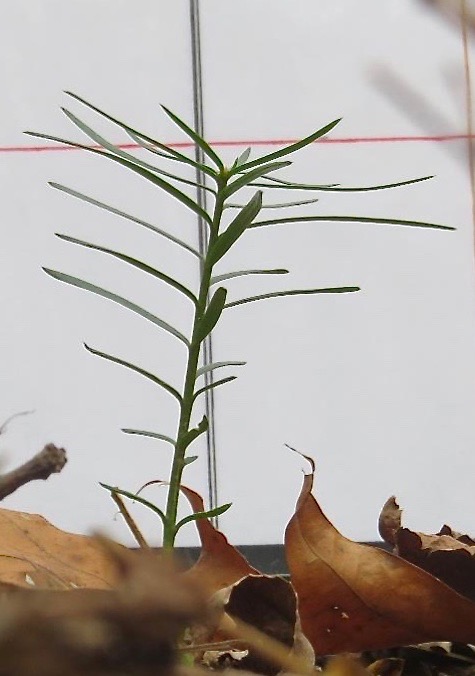 |
|
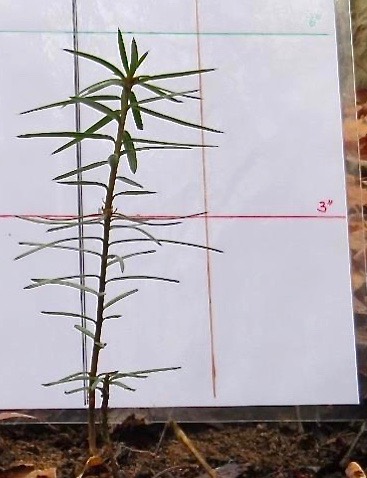 |
|
"Seedling Marker 7" appeared above ground only in NOV 2017 (photo far left), which is exactly four years after planting. It was not yet visible in May of 2017.
First appearance of a seedling is often in the late summer / early fall. Subsequently, new vegetative growth is usually in the spring. Vegetative growth may occur a second time in the same year during the late summer or early fall.
This seedling is also unusual. Instead of its second growth spurt making its first lateral branches (1 to 3 laterals is typical for initial layer), it chose to push its existing apical stem to a greater height (photo near left is JAN 2019).
|
3. TREMENDOUS ABILITY TO RECOVER FROM APICAL HERBIVORY: All seedlings spotted are still alive, as of 2019.
Photos below of "Seedling Marker 3" in sequence Nov 2016, May 2017, and Nov 2017
4. EVERGREEN FERNS PROVIDE CAMOUFLAGE: "Seedling D in Valley North of Trail" was spotted for the first time Summer 2017. The Stovers speculated that because it was already so developed (NOV 2017 photo below left) they had overlooked it because it was camouflaged by the neighboring evergreen ferns. As of JAN 2019 (photo below right) they report it "is still the largest of the seedlings." This suggests that it has entirely evaded herbivory — which leads to the hypothesis that ideal free-planting sites may be in the outer reach of evergreen fern fronds. Access photos of fern-protected torreya seedlings at other locations.
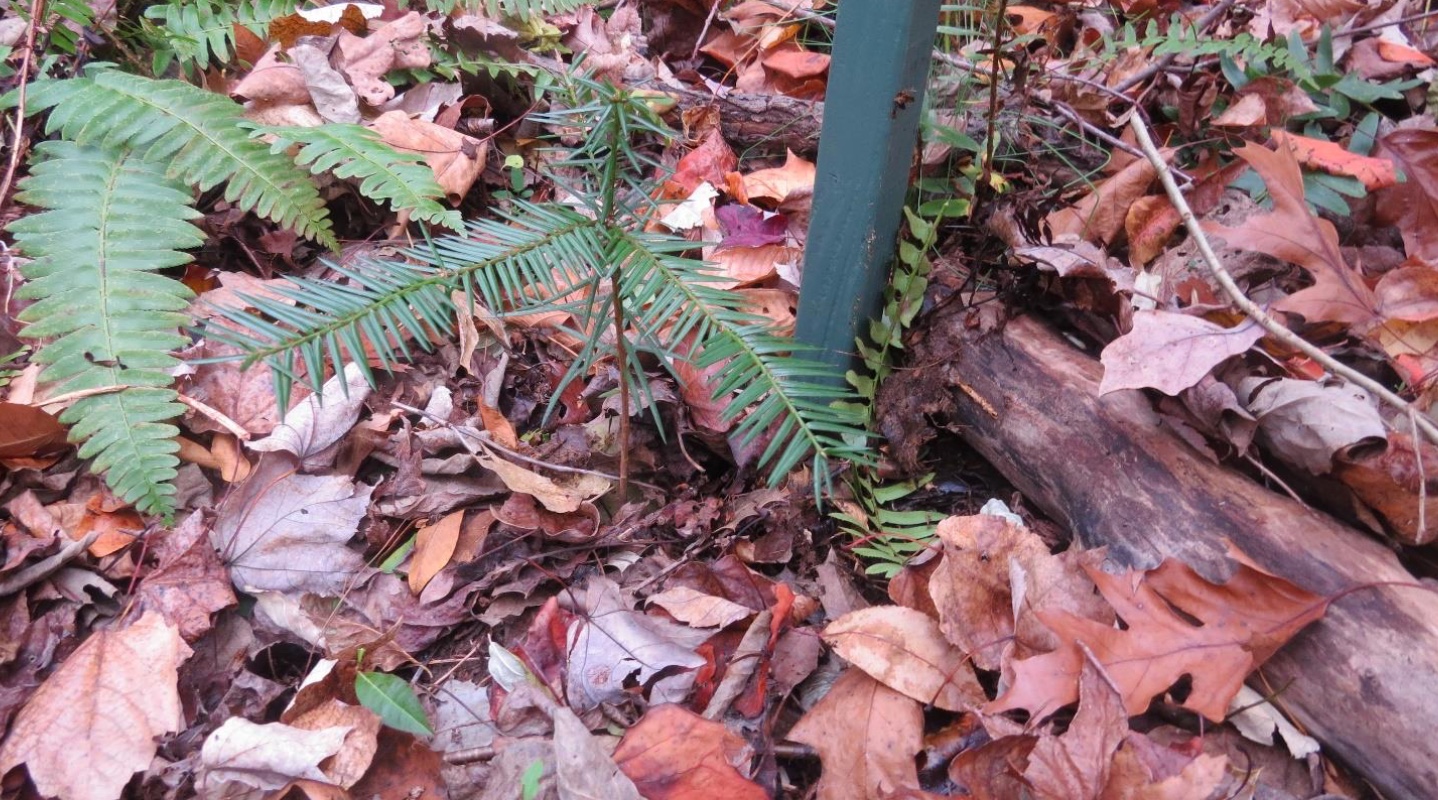
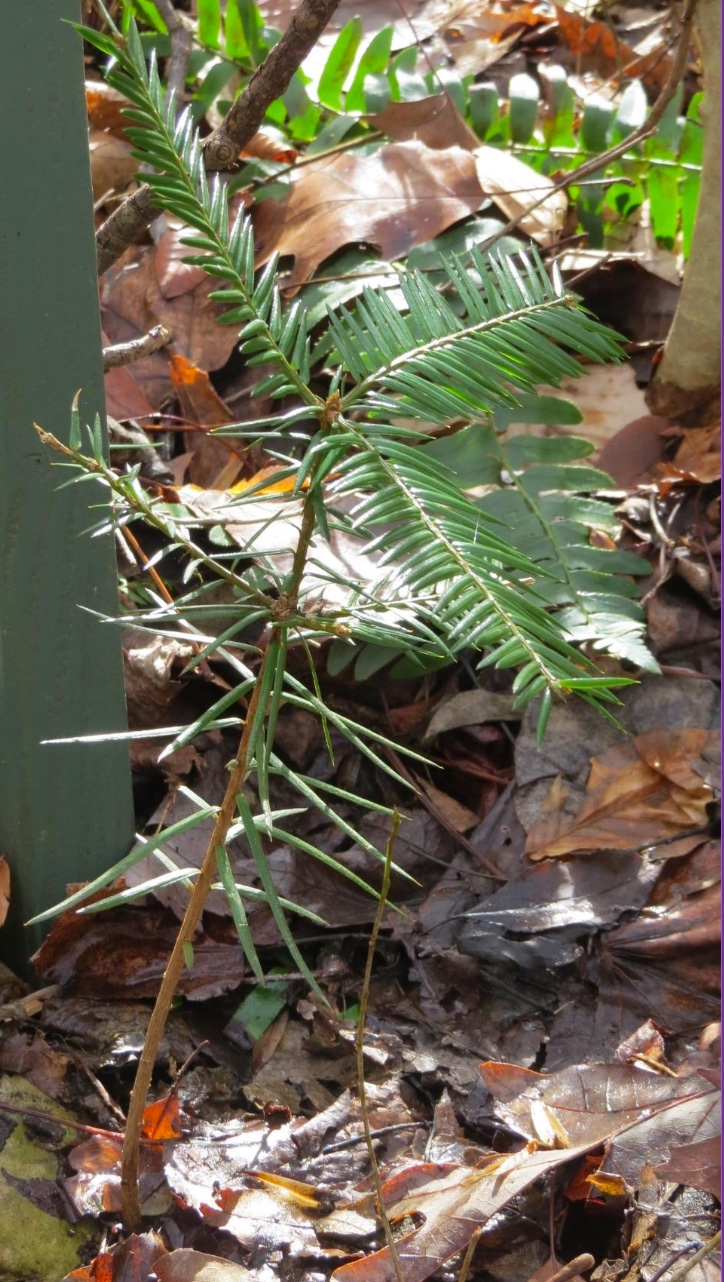
Ongoing Results
Chronologically from most recent
PHOTO LEFT: November 2021 is the tallest Torreya, with a view of its deciduous forest surroundings.
PHOTO RIGHT: November 2021 is another of the 2013 seed plantings that is growing well in the company of evergreen Christmas ferns. Both of these torreyas emerged from seeds planted directly into their forest soil, 3 inches deep, late 2013.
2018 and 2019 reports:
• Access all reports via links in list near top or at bottom of this webpage.
NOV 2017: Of the 30 seeds planted in November 2013, 22 had become little seedlings within these first four years. This is a remarkable success rate, likely attributable to seed-planting 3 inches deep. As well, 4 of the 22 seedlings emerged only late in the fourth year.Notably, 4 of those seedlings emerged only late in the fourth year. Twenty more seeds were planted November 2015; the first 7 of which appeared as seedlings between spring and summer of 2017. All seeds had been "free-planted" directly into the soil of the Stover's regrowth hardwood forest, with no overlying rock or wire protection.
In addition to substantial success in seeds escaping rodent predation underground, even seedlings that experienced substantial above-ground herbivory (whether by rodents, rabbits, or deer) have demonstrated superb capacity to regenerate — both by budding along the original stem and by sending up a basal sprout from just beneath the ground surface. (See pages 8 and 25 of the 2017 pdf report for photos of post-herbivory re-growth. Note that the seedling at Marker 3, which had been declared "no recovery" from herbivory in the Nov 2016 report, demonstrated remarkable recovery in the 2017 report.)
• Access the 35-page report: NOV 2017.
NOV 2016: Nelson and Elaine Stover revisited all the planting sites. None of the 20 seeds planted from the autumn 2015 seed stock are yet visible above ground. But 10 of the 30 seeds of the 2013 harvest had visible sprouts (a germination rate of 1 in 3). During this audit, a grid was placed behind each seedling to show its size in photos. The boxes on the grid are 2 inches wide and 3 inches tall. This November 2016 report (in pdf) includes photos from November 2013 (initial planting), May 2016, and November 2016. Some notes about specific disturbances to particular sites are also noted where applicable. In each of the original (2013) planting photos, Elaine Stover is holding a small trowel to point to the exact location of the planted seed.
Details by Numerical ID marker
#3 appeared Nov 2015; all leaves nibbled away by May 2016 (no recovery later)
#4 appeared Nov 2015; good health through Nov 2016
#5 new in Nov 2016
#6 new in Nov 2016
#14.25 new in Nov 2016
#14.75 new in Nov 2016
Final marker (Ecozoic) new in Nov 2016
Valley North group of 5 = 2 seedlings May 2016; 3 total by Nov 2016
Valley South group of 5 = 1 seedling new Nov 2015; almost entirely eaten May 2016; apparently dead Nov 2016
TOTAL GERMINATION as of Nov 2016 = 11 of 30
TOTAL SURVIVAL as of Nov 2016 = 9 of 30
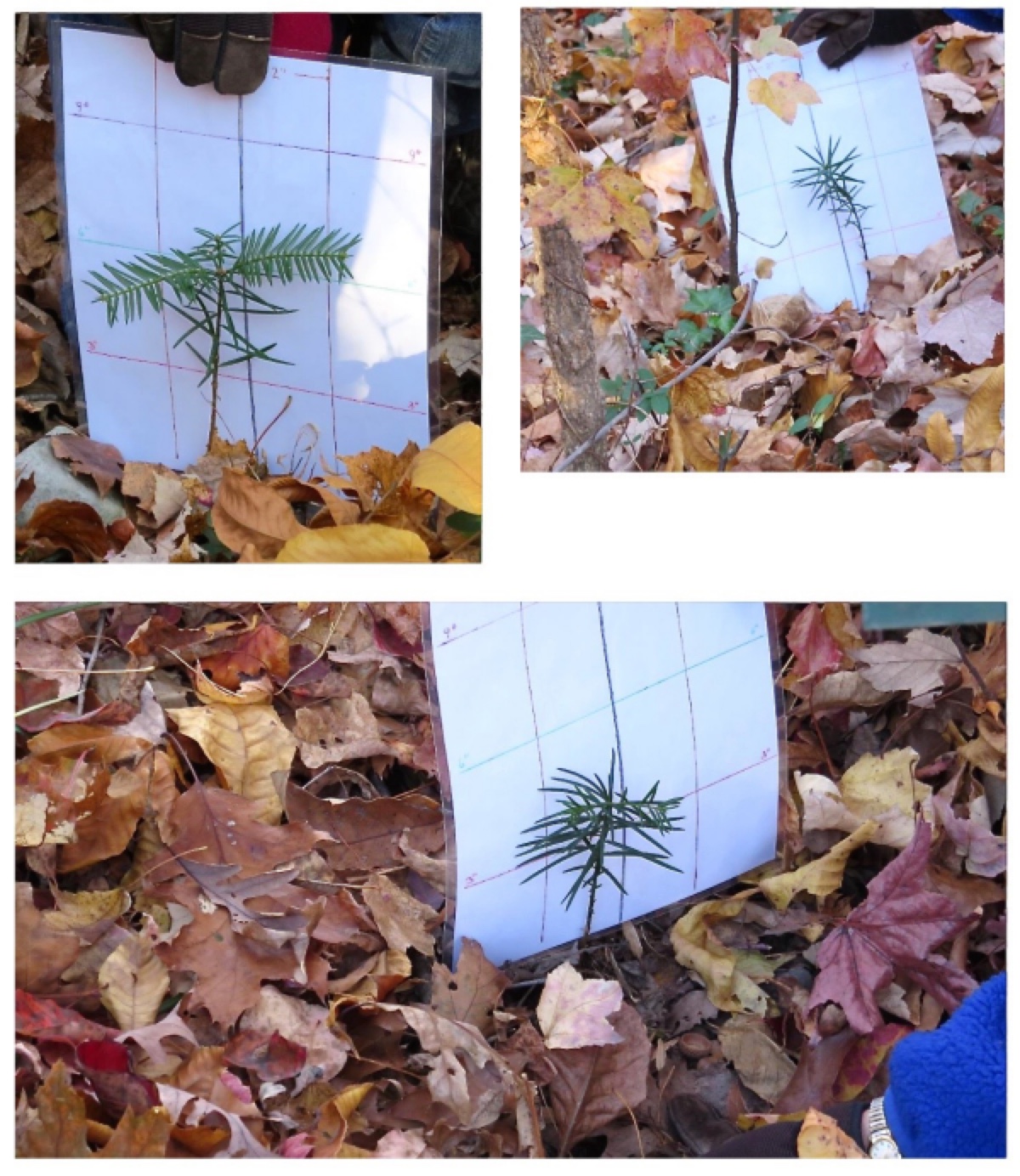 |
|
Left: The 3 seedlings visible in the Valley North locale as of November 2016.
Notice that the seedling pictured upper left obviously had 3 growth spurts (vertical, then lateral, then vertical), so it would have germinated in 2015. The other two seedlings are more difficult to read as to growth spurts.
Note: Grid boxes are 2 inches wide by 3 inches tall.
* * * * *
"Free-planting" refers to planting seeds directly into woodland soil (rather than starting them in protected pots or seed beds). The greatest challenges to free-planting are (a) seeds may be dug up and eaten by rodents, and (b) the young seedlings may be partially or entirely nibbled by deer and rabbits.
At least 1 (possibly 2) of the Greensboro germinated seedlings were severely injured by leaf herbivory within a year of germination.
|
MAY 2016: Nelson Stover and Michael Dowd conducted an in-depth examination of all planting locations. Three documentable plants were photographed — these are included in the May 2016 report, submitted by Nelson Stover (in pdf). The following day, in brighter sunlight, Nelson returned to the two sites in the valley. There he discovered the nubs of the three remaining plants (that had been noted the previous fall). It appears that the leaves of these three plants were eaten during the winter by deer or other small animals which are prevalent in the woods. Thus no new germination had occurred yet that spring, nor over the winter.
NOV 2015: Nelson Stover reported that 6 of the initial 30 seeds planted from the 2013 seed stock were visible as small seedlings above ground.
VIEW the November 2016 Report in pdf, submitted by Nelson Stover.
VIEW the May 2017 Report in pdf, submitted by Nelson Stover.
VIEW the November 2017 Report in pdf, submitted by Nelson Stover.
VIEW the December 2018 Report in pdf, submitted by Nelson Stover.
VIEW the November 2019 Report in pdf, submitted by Nelson Stover in two parts: Pt 1 and Pt 2.
Return to HOME PAGE